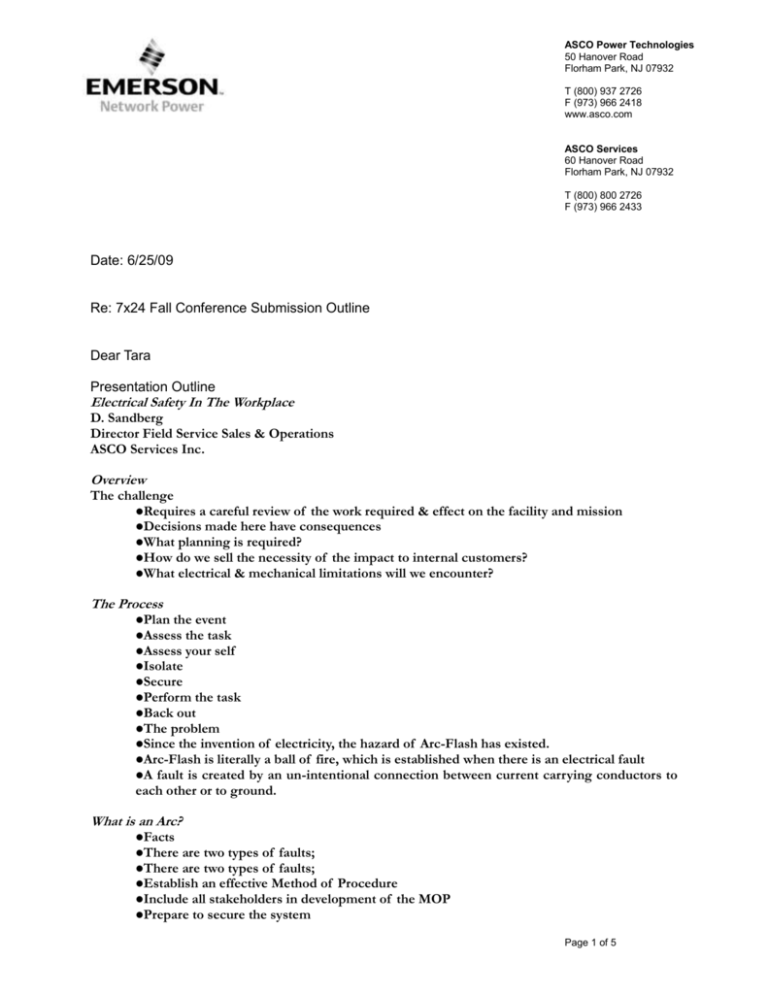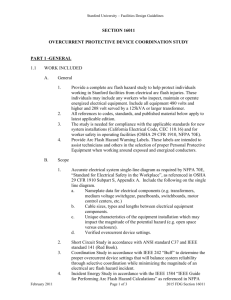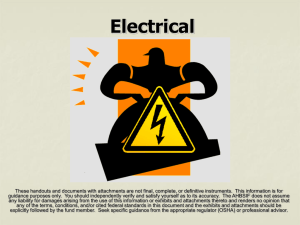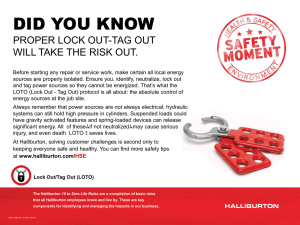ASCO Services - 7×24 Exchange International
advertisement

ASCO Power Technologies 50 Hanover Road Florham Park, NJ 07932 T (800) 937 2726 F (973) 966 2418 www.asco.com ASCO Services 60 Hanover Road Florham Park, NJ 07932 T (800) 800 2726 F (973) 966 2433 Date: 6/25/09 Re: 7x24 Fall Conference Submission Outline Dear Tara Presentation Outline Electrical Safety In The Workplace D. Sandberg Director Field Service Sales & Operations ASCO Services Inc. Overview The challenge Requires a careful review of the work required & effect on the facility and mission Decisions made here have consequences What planning is required? How do we sell the necessity of the impact to internal customers? What electrical & mechanical limitations will we encounter? The Process Plan the event Assess the task Assess your self Isolate Secure Perform the task Back out The problem Since the invention of electricity, the hazard of Arc-Flash has existed. Arc-Flash is literally a ball of fire, which is established when there is an electrical fault A fault is created by an un-intentional connection between current carrying conductors each other or to ground. What is an Arc? Facts There are two types of faults; There are two types of faults; Establish an effective Method of Procedure Include all stakeholders in development of the Prepare to secure the system MOP Page 1 of 5 to PPE is required to operate Establish boundaries breakers & disconnects Establishing Boundaries Flash Protection Boundary = The closest approach by any person without PPE. Approach Boundary = The limit of approach for any unqualified person. Restricted Approach Boundary = The limit of approach by qualified persons wearing PPE and having a written MOP. Only as absolutely necessary to perform the required task Prohibited Approach Boundary = Considered the same as touching an energized part. Prior to approach, a risk assessment is required. The challenge Limited Knowledge is the Weapon of Choice In order to be adequately equipped, we need some information. We need an arc-flash analysis. Flash Hazard Analysis An arc flash hazard analysis shall be done to protect personnel from injury by arc flash exposure Three Options Flash Hazard Analysis An arc flash hazard analysis shall be done to protect personnel from injury by arc flash exposure Three Options Typical Equipment Label Flash Hazard Analysis Three Options Flash Hazard Analysis This analysis determines the flash protection boundary and potential thermal exposure to personnel working on or near exposure live parts within the boundary. NFPA 70E provides the calculations required. This method is complex and requires information not always available. The next slide explains the issues involved. Flash Hazard Analysis The problem is…we don’t know what we need to know to accurately calculate the arc flash boundary. Even if the equipment is stickered changing a component may change the original analysis calculations Flash Hazard Analysis The Bolted current calculation requires Flash Hazard Analysis In order to calculate the Arc flash protection boundary We would need to know –The Bolted Fault Current (unlikely – see above –The bus bar voltage –The trip speed of the fault protection device controlling our equipment. We rarely work in buildings where we can get accurate information regarding the breaker trip speed. Example, if the feed breaker has been tripping in a building, the electrical engineer may place a longer trip system in to prevent losing power. “ Flash Hazard Analysis An arc flash hazard analysis shall be done to protect personnel from injury by arc flash exposure Three Options Page 2 of 5 Flash Hazard Analysis Job Safety Analysis Another alternative is the JSA (Job Safety Analysis) A document tailored to each piece of standard equipment The JSA outlines the equipment, task, the hazards and category of PPE required Typical Equipment Label NFPA 70E 130.7 Examples of PPE Establishing Boundaries Having determined the Incident Energy available will enable the calculation of very specific boundaries. Establishing Boundaries Having determined the Incident Energy available will enable the calculation of very specific boundaries. Establishing Boundaries Typical Equipment Label NFPA 70E 130.7 Required PPE Arc Flash Protection Secure the System (LOTO) Lock Out / Tag Out (LOTO) A team sport requiring 100% participation, the winner stays NFPA 70 E Article 120 spells out the precautions necessary alive Secure the System (LOTO) Electrical Lock Out / Tag Out Secure the System (LOTO) Lock Out / Tag Out Lock Out / Tag Out Secure the System (LOTO) Secure the System (LOTO) Prevent inadvertent operation of the equipment or process in Establish standard methods for achieving a zero energy state Comply with applicable standards order to protect employees Secure the System (LOTO) Standards LOTO Definitions Energy apply but are not limited to; isolating device = a physical apparatus which prevents the transmission or release of energy such as, but not limited to the following: –Restraint blocks = manually operated electrical circuits breakers, disconnect switches, slide gates, and slip blinds or line valves. Where possible, they shall provide visible indication of the position of the device. Push button, selector switches and other portions of the control circuit shall not be considered as energy isolating devices. Lockout / Tagout = The placement of a lock/tag on an energy isolating device in accordance with an established procedure, indicating that the energy isolating device shall not be operated or removed until the lock/tag has been cleared. Page 3 of 5 Lockout device = Examples include locks, chains, blank flanges and bolted slip blinds. Lock-out devices are used to hold an energy-isolating device in a safe position and to prevent the start-up of machinery or equipment. Whenever possible a lockout device must be used along with a tagout device. An example of this is when you lockout an electrical disconnect, you must attach the warning tag to the lock shackle and then attach both the lock and tag to the disconnect. Never remove a lockout that does not belong to you. Tagout device = A tag and a nylon tie that is securely fastened to an energy-isolating device to indicate that the machine cannot be operated until the tagout device is removed. A tag alone will only serve as a warning device - people can easily remove tags, putting you at risk. Never remove a tagout that does not belong to you. Employee Tag = A warning appliance used for the purpose of personnel protection. Its legend forbids the operation or removal of any energy isolating device and identifies the applier. Zero Energy State = A state in which every equipment/process energy source has been controlled either by lockout/tagout or other protective techniques to prevent the unexpected release or transmission of energy. Qualified Individual = An individual who understands how to effectively control the equipment/process through application of energy isolating devices. Authorized Individual = A knowledgeable individual processing the responsibility and authority to perform a specific assignment. Affected Individual = An affected individual is not qualified to lock/tag out a piece of equipment, but uses/operates a machine or piece of equipment which lead to maintenance or servicing needs. Lock Out / Tag Out –Verify with drawings –Secure all sources identified –Each individual involved must apply their personal lock & tag –Each individual involved must test the source and verify it is secure Secure the System –Complex events involve multiple teams & systems –Requires a written plan –Requires a manager Arc Flash Protection Back Out & Return System to Service –Gather all team members and review work done –Inspect all gear involved •Are all assemblies, shields etc. installed? •Are all tools accounted for? •Are all team members present? •Do all concur that conditions are safe to re-apply power? –Each individual must remove their lock & tag from the disconnecting means –Re-close all disconnecting means –Test to ensure that all phases are present –Test each peace of gear worked on –Sign off plan Electrical Safety The Page 4 of 5 Conclusion –Electrical safety is a central concern –A safety policy is mandatory –It is our combined responsibility to protect people, facilities & companies –Many systems do not have concurrent maintainability features The Conclusion –PPE is required to be worn by persons in the vicinity of energized equipment –Studies similar to breaker coordination to determine the class of hazard at a given piece of equipment based on the potential energy available –PPE severely limits the type of work which can be done –All maintenance routines require equipment to be secured, locked out & tagged out and possibly removed from the area Questions? Contact: Doug Sandberg Director Field Service Sales & Operations ASCO Services Inc. (973) 966 2079 doug.sandberg@emerson.com Douglas H. Sandberg Douglas H. Sandberg Director, US Field Sales & Service Operations ASCO Services Cc Page 5 of 5







